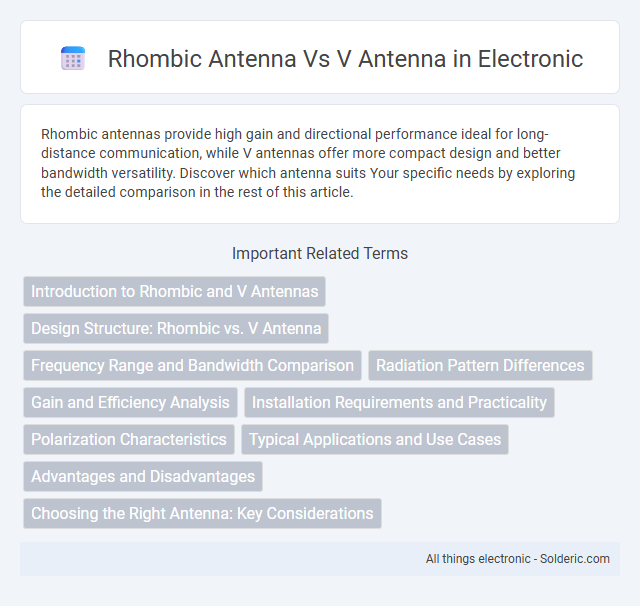Rhombic antennas provide high gain and directional performance ideal for long-distance communication, while V antennas offer more compact design and better bandwidth versatility. Discover which antenna suits Your specific needs by exploring the detailed comparison in the rest of this article.
Comparison Table
| Feature | Rhombic Antenna | V Antenna |
|---|---|---|
| Structure | Large diamond-shaped wire antenna | Two wires forming a V shape |
| Radiation Pattern | Directional with high gain | Directional but less gain than rhombic |
| Frequency Range | Broadband, HF frequencies (3-30 MHz) | Narrower bandwidth, HF range |
| Gain | Typically 10-20 dBi | Usually 6-10 dBi |
| Size | Large, requires significant space | Compact compared to rhombic |
| Construction Complexity | Complex, needs precise installation | Simple and easier to build |
| Use Cases | Long-distance HF communication, broadcasting | Medium-range HF communication |
| Impedance Matching | Can be challenging, requires balun or tuner | Easier to match impedance |
Introduction to Rhombic and V Antennas
Rhombic antennas, recognized for their high-gain directional properties, consist of four wires forming a diamond shape, optimizing long-distance HF communications. V antennas, shaped like the letter "V," provide broad bandwidth and relatively simple construction, suited for multi-band operation and space-constrained installations. Both antenna types are favored for their efficiency in transmitting and receiving high-frequency signals, with design differences affecting gain, radiation patterns, and installation complexity.
Design Structure: Rhombic vs. V Antenna
The rhombic antenna features a large, diamond-shaped wire structure with four equal-length sides, optimized for high gain and directional transmission over long distances. In contrast, the V antenna consists of two wires arranged in a V-shape with an adjustable apex angle, allowing for easier installation and directional flexibility but generally lower gain compared to the rhombic design. The rhombic's complex geometry demands more space and support poles, while the V antenna's simpler layout requires less physical infrastructure, influencing their practical deployment scenarios.
Frequency Range and Bandwidth Comparison
Rhombic antennas typically operate efficiently across a wide frequency range, often from 3 MHz to 30 MHz, providing broad bandwidth suitable for high-frequency communications. V antennas generally cover a narrower frequency spectrum with more limited bandwidth, optimized for specific HF bands depending on their design and dimensions. The rhombic antenna's large structure and multiple termination points contribute to its superior bandwidth performance compared to the simpler V antenna configuration.
Radiation Pattern Differences
The rhombic antenna exhibits a highly directional radiation pattern with a narrow beamwidth, yielding strong gain and long-distance communication capabilities ideal for high-frequency transmission. The V antenna, by contrast, produces a broader, less directional radiation pattern with increased elevation angle coverage, suitable for regional or medium-range broadcasts. These radiation pattern differences influence their application, with rhombic antennas favoring point-to-point links and V antennas being better for wider area coverage.
Gain and Efficiency Analysis
Rhombic antennas typically offer higher gain, often ranging between 10 to 15 dBi, due to their larger aperture and longer wire length, resulting in increased directional efficiency. V antennas provide slightly lower gain, generally around 6 to 9 dBi, but they maintain good efficiency with a simpler structure and smaller footprint. For your application, selecting a rhombic antenna can maximize signal strength over long distances, while a V antenna balances gain and efficiency in a more compact design.
Installation Requirements and Practicality
Rhombic antennas require substantial space and precise directional alignment, making their installation more complex and suited for fixed, long-distance communication setups. V antennas, with simpler geometry and smaller footprint, offer easier installation and greater practicality for limited spaces or portable operations. Depending on Your site constraints and operational needs, selecting between these antennas impacts setup time, structural support, and maintenance.
Polarization Characteristics
The rhombic antenna typically exhibits linear polarization with a stable polarization plane, making it highly effective for long-distance HF communications. In contrast, the V antenna's polarization can vary depending on the angle between its elements, often resulting in mixed or elliptical polarization patterns. Understanding the polarization characteristics is crucial for optimizing signal reception and minimizing polarization mismatch losses in radio communication systems.
Typical Applications and Use Cases
Rhombic antennas are widely used for high-frequency (HF) point-to-point long-distance communication due to their high gain and directional characteristics, making them ideal for international broadcasting and military communications. V antennas, or V-beam antennas, are commonly employed for short to medium-range HF communication where space constraints exist, offering easier installation and moderate gain suitable for amateur radio and regional broadcasting. Your choice depends on whether you prioritize long-range performance with rhombic antennas or more compact, versatile deployment with V antennas.
Advantages and Disadvantages
Rhombic antennas offer high gain and broad bandwidth, making them ideal for long-distance HF communications but require large physical space and complex installation. V antennas are more compact and easier to install, providing directional gain with fewer materials, but they generally have lower gain and narrower bandwidth compared to rhombic antennas. The choice depends on the specific application, available space, and desired frequency range.
Choosing the Right Antenna: Key Considerations
When choosing between a rhombic antenna and a V antenna, consider factors like gain, bandwidth, and installation space. A rhombic antenna offers high gain and wide bandwidth, ideal for long-distance, high-frequency communications but requires significant space and support structures. Your choice should balance performance needs with available installation area and directional requirements.
rhombic antenna vs V antenna Infographic

 solderic.com
solderic.com